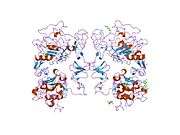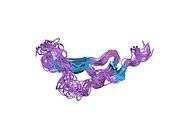Epidermal growth factor
Epidermal growth factor or EGF is a growth factor that stimulates cell growth, proliferation, and differentiation by binding to its receptor EGFR. Human EGF is a 6045-Da protein[2] with 53 amino acid residues and three intramolecular disulfide bonds.[3]
Function
EGF results in cellular proliferation, differentiation, and survival.[4] EGF is a low-molecular-weight polypeptide first purified from the mouse submandibular gland, but since then found in many human tissues including submandibular gland, parotid gland. Salivary EGF, which seems also regulated by dietary inorganic iodine, also plays an important physiological role in the maintenance of oro-esophageal and gastric tissue integrity. The biological effects of salivary EGF include healing of oral and gastroesophageal ulcers, inhibition of gastric acid secretion, stimulation of DNA synthesis as well as mucosal protection from intraluminal injurious factors such as gastric acid, bile acids, pepsin, and trypsin and to physical, chemical and bacterial agents.[5]
Biological sources
Epidermal growth factor can be found in urine, saliva, milk, and plasma.[6] The production of epidermal growth factor has been found to be stimulated by testosterone.
Mechanism

EGF acts by binding with high affinity to epidermal growth factor receptor (EGFR) on the cell surface. This stimulates ligand-induced dimerization,[7] activating the intrinsic protein-tyrosine kinase activity of the receptor (see the second diagram). The tyrosine kinase activity, in turn, initiates a signal transduction cascade that results in a variety of biochemical changes within the cell - a rise in intracellular calcium levels, increased glycolysis and protein synthesis, and increases in the expression of certain genes including the gene for EGFR - that ultimately lead to DNA synthesis and cell proliferation.[8]
EGF-family
EGF is the founding member of the EGF-family of proteins. Members of this protein family have highly similar structural and functional characteristics. Besides EGF itself other family members include:[9]
- Heparin-binding EGF-like growth factor (HB-EGF)
- transforming growth factor-α (TGF-α)
- Amphiregulin (AR)
- Epiregulin (EPR)
- Epigen
- Betacellulin (BTC)
- neuregulin-1 (NRG1)
- neuregulin-2 (NRG2)
- neuregulin-3 (NRG3)
- neuregulin-4 (NRG4).
All family members contain one or more repeats of the conserved amino acid sequence:
Where X represents any amino acid.[9]
This sequence contains 6 cysteine residues that form three intramolecular disulfide bonds. Disulfide bond formation generates three structural loops that are essential for high-affinity binding between members of the EGF-family and their cell-surface receptors.[10]
EGF therapy
Increased activity of the epidermal growth factor receptor (EGFR) has been observed in certain types of cancer, often correlated with mutations in the receptor and abnormal function such as constitutive receptor signalling independent of the levels of EGF or of binding of EGF.[11] Thus EGF and EGFR have been exploited to develop imaging methods and targeted therapies against cancers overexpressing EGFR.
Pharmaceutical drugs developed for inhibiting the EGF receptor include gefitinib, erlotinib, afatinib and osimertinib for lung cancer, and Cetuximab for colon cancer. EGFR inhibitors are either tyrosine kinase inhibitors or monoclonal antibodies that slow down or halt cell growth. CimaVax-EGF, an active vaccine targeting EGF as the major ligand of EGF, raises antibodies against EGF itself, thereby denying EGFR-dependent cancers of a proliferative stimulus;[12] it is in use as a cancer therapy against non-small-cell lung carcinoma (the most common form of lung cancer) in Cuba, and is undergoing further trials for possible licensing in Japan, Europe, and the United States.[13]
Imaging agents have been developed which identify EGFR-dependent cancers using labeled EGF.[14] or anti-EGFR [15]
Interactions
Epidermal growth factor has been shown to interact with epidermal growth factor receptor.[16][17]
References
- ↑ PDB: 1a3p; Barnham KJ, Torres AM, Alewood D, Alewood PF, Domagala T, Nice EC, Norton RS (August 1998). "Role of the 6-20 disulfide bridge in the structure and activity of epidermal growth factor". Protein Science 7 (8): 1738–49. doi:10.1002/pro.5560070808. PMC 2144085. PMID 10082370.
- ↑ Harris RC, Chung E, Coffey RJ (March 2003). "EGF receptor ligands". Experimental Cell Research 284 (1): 2–13. doi:10.1016/S0014-4827(02)00105-2. PMID 12648462.
- ↑ Carpenter G, Cohen S (May 1990). "Epidermal growth factor". The Journal of Biological Chemistry 265 (14): 7709–12. PMID 2186024.
- ↑ Herbst RS (2004). "Review of epidermal growth factor receptor biology". International Journal of Radiation Oncology, Biology, Physics 59 (2 Suppl): 21–6. doi:10.1016/j.ijrobp.2003.11.041. PMID 15142631.
- ↑ Venturi S, Venturi M (2009). "Iodine in evolution of salivary glands and in oral health". Nutrition and Health 20 (2): 119–134. doi:10.1177/026010600902000204. PMID 19835108.
- ↑ Cotran, Ramzi S.; Kumar, Vinay; Fausto, Nelson; Nelso Fausto; Robbins, Stanley L.; Abbas, Abul K. (2005). Robbins and Cotran pathologic basis of disease. St. Louis, Mo: Elsevier Saunders. ISBN 0-7216-0187-1.
- ↑ Dawson JP, Berger MB, Lin CC, Schlessinger J, Lemmon MA, Ferguson KM (2005). "Epidermal growth factor receptor dimerization and activation require ligand-induced conformational changes in the dimer interface". Mol. Cell. Biol. 25 (17): 7734–42. doi:10.1128/MCB.25.17.7734-7742.2005. PMC 1190273. PMID 16107719.
- ↑ Fallon JH, Seroogy KB, Loughlin SE, Morrison RS, Bradshaw RA, Knaver DJ, Cunningham DD (June 1984). "Epidermal growth factor immunoreactive material in the central nervous system: location and development". Science 224 (4653): 1107–9. doi:10.1126/science.6144184. PMID 6144184.
- 1 2 Dreux AC, Lamb DJ, Modjtahedi H, Ferns GA (May 2006). "The epidermal growth factor receptors and their family of ligands: their putative role in atherogenesis". Atherosclerosis 186 (1): 38–53. doi:10.1016/j.atherosclerosis.2005.06.038. PMID 16076471.
- ↑ Harris RC, Chung E, Coffey RJ (2003). "EGF receptor ligands". Exp. Cell. Res. 284 (1): 2–13. doi:10.1016/S0014-4827(02)00105-2. PMID 12648462.
- ↑ Lurje G., et al., "EGFR Signalling and Drug Discovery", Oncology 77: 400-410 (2009)
- ↑ Rodríguez, Pedro C; Rodríguez, Gryssell; González, Giselaa; Lage, Agustín (Winter 2010). "Clinical development and perspectives of CIMAvax EGF, Cuban vaccine for non-small-cell lung cancer therapy". MEDICC Rev 12 (1): 17–23. PMID 20387330. Retrieved 13 May 2015.
- ↑ Patel, Neel (11 May 2015). "Cuba Has a Lung Cancer Vaccine—And America Wants It". Wired. Retrieved 13 May 2015.
- ↑ L. J. Lucas, C. A. Tellez , M. L. Castilho , C. L. D. Lee , M. A. Hupman , L. S. Vieira , I. Ferreira , L. Raniero , K. C. Hewitt. "Development of a sensitive, stable and EGFR-specific molecular imaging agent for surface enhanced Raman spectroscopy", Journal of Raman Spectroscopy DOI 10.1002/jrs.4678 (2015)
- ↑ L. J. Lucas , X. K. Chen , A. J. Smith , M. Korbelik , H. Zeng , P. W. K. Lee and K. C. Hewitt. "Aggregation of nanoparticles in endosomes and lysosomes produce Surface Enhanced Raman Spectroscopy", Journal of Nanophotonics 9: 093094-1-14 (2015).
- ↑ Stortelers C, Souriau C, van Liempt E, van de Poll ML, van Zoelen EJ (July 2002). "Role of the N-terminus of epidermal growth factor in ErbB-2/ErbB-3 binding studied by phage display". Biochemistry 41 (27): 8732–41. doi:10.1021/bi025878c. PMID 12093292.
- ↑ Wong L, Deb TB, Thompson SA, Wells A, Johnson GR (March 1999). "A differential requirement for the COOH-terminal region of the epidermal growth factor (EGF) receptor in amphiregulin and EGF mitogenic signaling". J. Biol. Chem. 274 (13): 8900–9. doi:10.1074/jbc.274.13.8900. PMID 10085134.
Further reading
- Boonstra J, Rijken P, Humbel B, Cremers F, Verkleij A, van Bergen en Henegouwen P (1995). "The epidermal growth factor". Cell Biol. Int. 19 (5): 413–30. doi:10.1006/cbir.1995.1086. PMID 7640657.
- Dvorak B (2004). "Epidermal growth factor and necrotizing enterocolitis". Clinics in perinatology 31 (1): 183–92. doi:10.1016/j.clp.2004.03.015. PMID 15183666.
- Howell WM (2004). "Epidermal growth factor gene polymorphism and development of cutaneous melanoma". J. Invest. Dermatol. 123 (4): xx–xxi. doi:10.1111/j.0022-202X.2004.23308.x. PMID 15373802.
External links
| Wikimedia Commons has media related to Epidermal growth factor, EGF. |
- Shaanxi Zhongbang Pharma-Tech Co., Ltd.-Supply of Epidermal Growth Factor
- EGF at the Human Protein Reference Database.
- Epidermal growth factor at the US National Library of Medicine Medical Subject Headings (MeSH)
- EGF model in BioModels database
| |||||||||||||||
| ||||||||||||||||||||||||||||||||||||||||||||
| ||||||||||||||||||||||||||||||||||||||||||||||||||||||||||||||||||||||||||||||||||||||||||||||





